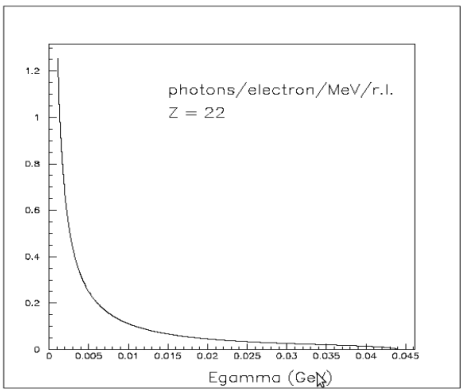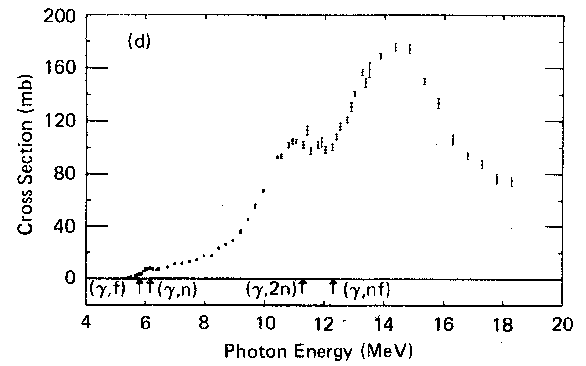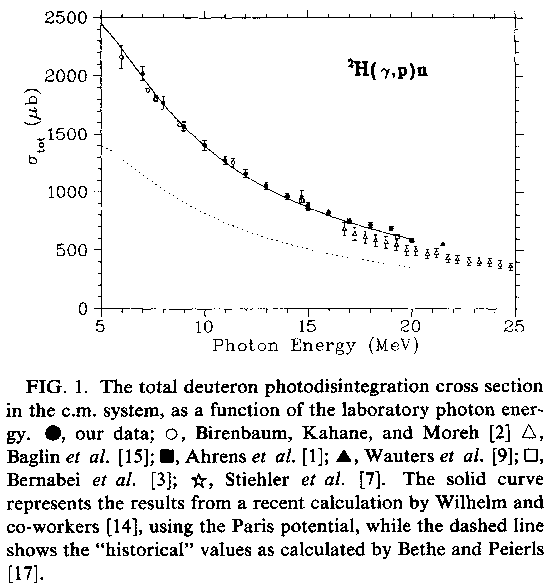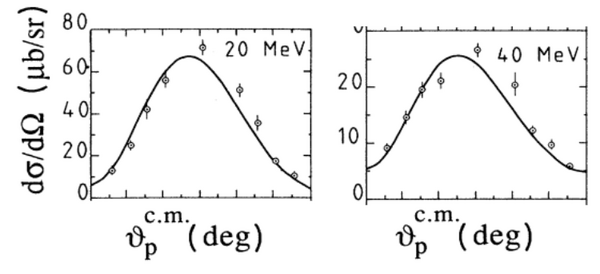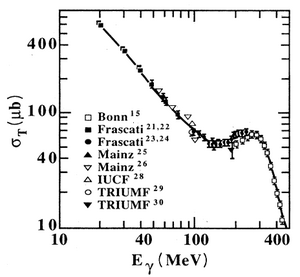Difference between revisions of "Counts Rate (44 MeV LINAC)"
(→Yield) |
|||
| (8 intermediate revisions by the same user not shown) | |||
| Line 1: | Line 1: | ||
| − | [ | + | [https://wiki.iac.isu.edu/index.php/Roman_calculation Go Back] |
=LINAC parameters used in calculations= | =LINAC parameters used in calculations= | ||
| Line 106: | Line 106: | ||
fractional solid angle = <math>\frac{40\ cm^{2}}{4 \pi\ (100\ cm)^{2}} = 3.2 \cdot 10^{-4}</math> <= geometrical acceptance | fractional solid angle = <math>\frac{40\ cm^{2}}{4 \pi\ (100\ cm)^{2}} = 3.2 \cdot 10^{-4}</math> <= geometrical acceptance | ||
| − | ==Yield== | + | ==Yield (1/2 mil of Ti and without detector efficiency)== |
the yield per second: | the yield per second: | ||
| Line 116: | Line 116: | ||
<math> 53.8\ \frac{neutrons}{sec} \times \frac{1\ sec}{300\ pulses} = 0.18\ \frac{neutrons}{pulse} </math> <br><br> | <math> 53.8\ \frac{neutrons}{sec} \times \frac{1\ sec}{300\ pulses} = 0.18\ \frac{neutrons}{pulse} </math> <br><br> | ||
| − | :'''53.8 neutrons/sec | + | :'''53.8 neutrons/sec <= this experiment is do able''' |
| − | :'''0.18 neutrons/pulse | + | :'''0.18 neutrons/pulse <= good for stopping pulse''' |
=Counts Rate for U238 (1/2 mil of Al converter)= | =Counts Rate for U238 (1/2 mil of Al converter)= | ||
| Line 138: | Line 138: | ||
1.41 (1/2 mil Al) / 3.48 (1/2 mil Ti) = 0.40 | 1.41 (1/2 mil Al) / 3.48 (1/2 mil Ti) = 0.40 | ||
| − | ==Yield== | + | ==Yield (1/2 mil of Al and without detector efficiency)== |
| − | : | + | :'''53.8 neutrons/sec * 0.40 = 21.5 neutrons/sec ''' |
| − | : | + | :'''0.18 neutrons/pulse * 0.40 = 0.07 neutrons/pulse ''' |
| − | =Counts Rate for Deuteron ( | + | =Counts Rate for Deuteron (1/2 mil of Ti converter)= |
===photonuclear cross section for <math> ^2H(\gamma , n) </math> reaction=== | ===photonuclear cross section for <math> ^2H(\gamma , n) </math> reaction=== | ||
| Line 250: | Line 250: | ||
<math>\frac{1}{130} \times \frac{66}{0.48} \times \frac{1}{2.4} \times \frac{3.4}{3.2} = 0.468</math> | <math>\frac{1}{130} \times \frac{66}{0.48} \times \frac{1}{2.4} \times \frac{3.4}{3.2} = 0.468</math> | ||
| − | ===Yield=== | + | ===Yield (1/2 mil of Ti and without detector efficiency)=== |
saying all other factors is the same => | saying all other factors is the same => | ||
| Line 260: | Line 260: | ||
the yield per pulse: | the yield per pulse: | ||
| − | <math> | + | <math> 25.2\ \frac{neutrons}{sec} \times \frac{1\ sec}{300\ pulses} = 0.08\ \frac{neutrons}{pulse} </math><br><br> |
| − | =Summary= | + | =Summary (counts rate without neutron efficiency for different radiator thickness= |
{| border="1" cellpadding="20" cellspacing="0" | {| border="1" cellpadding="20" cellspacing="0" | ||
Latest revision as of 19:03, 24 May 2012
LINAC parameters used in calculations
1) pulse width 50 ps
2) pulse current 50 A
3) repetition rate 300 Hz
4) energy 44 MeV
Counts Rate for U238 (1/2 mil of Ti radiadot)
Number of electrons/sec on radiator
Number of photons/sec on target
bremsstrahlung
in (10,20) MeV region we have about
0.1 photons/electrons/MeV/r.l
radiation length
r.l.(Ti) = 3.59 cm
radiator thickness = 12.5
steps together...
Alex factor (GEANT4 calculation)
Collimation factor is
6.85 % of total # of photons
then, incident flux on target is
Number of neutrons/sec
photonuclear cross section for reaction
J. T. Caldwell et all., Phys. Rev. C21, 1215 (1980):
in (10,20) MeV region the average cross section, say, is:
130 mb
target thickness,
Let's target thickness = 1 mm:
neutrons per fission
2.4 neutrons/fission
steps together...yeild
Worst Case Isotropic Neutrons
checking detector distance
we want:
the time of flight of neutron >> the pulse width
take the worst case 10 MeV neutron:
take the neutron detector 1 meter away:
23 ns >> 50 ps <= time resolution is good
geometrical factor
taking real detector 3" x 2" => S is about 40 cm^2
1 meter away
fractional solid angle = <= geometrical acceptance
Yield (1/2 mil of Ti and without detector efficiency)
the yield per second:
the yield per pulse:
- 53.8 neutrons/sec <= this experiment is do able
- 0.18 neutrons/pulse <= good for stopping pulse
Counts Rate for U238 (1/2 mil of Al converter)
radiation length
r.l.(Al) = 8.89 cm
radiator thickness = 12.5
Calibration factor
The only difference from calculations above is:
1) radiation length:
1.41 (1/2 mil Al) / 3.48 (1/2 mil Ti) = 0.40
Yield (1/2 mil of Al and without detector efficiency)
- 53.8 neutrons/sec * 0.40 = 21.5 neutrons/sec
- 0.18 neutrons/pulse * 0.40 = 0.07 neutrons/pulse
Counts Rate for Deuteron (1/2 mil of Ti converter)
photonuclear cross section for reaction
A. De Graeva et all., Phys. Rev. C45, 860 (1992):
in (10,20) MeV region the average cross section, say, is:
1000 μb
target thickness,
take , liquid (20°C):
Let's target thickness = 10 cm:
angular distribution of neutron
P. Rossi et all., Phys. Rev. C40, 2412 (1989):
relativistic kinematics
An Introduction to Nuclear and Subnuclear Physics. Emilio Segre (1964)
where
asterisks are quantities referred to CM
barred quantities refer to the velocity of the CM
calculations
| 20 MeV | ||||||
| 40 MeV |
geometrical factor
taking average for 20 and 40 MeV photons
geometrical acceptance =
Calibration factor
The only differences from calculations above are:
1) cross section correction:
1000 μb (D) / 130 mb (238U) = 1/130
2) target thickness correction:
3) neutrons per reaction correction:
1 neutron (D) / 2.4 neutrons(238U) = 1/2.4
4) geometrical factor correction:
total calibration factor is:
Yield (1/2 mil of Ti and without detector efficiency)
saying all other factors is the same =>
the yield per second :
the yield per pulse:
Summary (counts rate without neutron efficiency for different radiator thickness
| converter | target | neutrons/sec | neutrons/pulse |
| 1/2 mil Ti | 53.8 | 0.18 | |
| 1/2 mil Al | 21.5 | 0.07 | |
| 1/2 mil Ti | 25.2 | 0.08 | |
| 1/2 mil Al | 10.1 | 0.03 |
